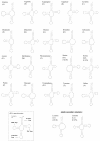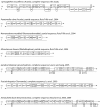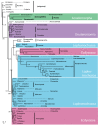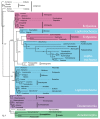The phylogenetic position of Acoela as revealed by the complete mitochondrial genome of Symsagittifera roscoffensis
- PMID: 20942955
- PMCID: PMC2973942
- DOI: 10.1186/1471-2148-10-309
The phylogenetic position of Acoela as revealed by the complete mitochondrial genome of Symsagittifera roscoffensis
Abstract
Background: Acoels are simply organized unsegmented worms, lacking hindgut and anus. Several publications over recent years challenge the long-held view that acoels are early offshoots of the flatworms. Instead a basal position as sister group to all other bilaterian animals was suggested, mainly based on molecular evidence. This led to the view that features of acoels might reflect those of the last common ancestor of Bilateria, and resulted in several evo-devo studies trying to interpret bilaterian evolution using acoels as a proxy model for the "Urbilateria".
Results: We describe the first complete mitochondrial genome sequence of a member of the Acoela, Symsagittifera roscoffensis. Gene content and circular organization of the mitochondrial genome does not significantly differ from other bilaterian animals. However, gene order shows no similarity to any other mitochondrial genome within the Metazoa. Phylogenetic analyses of concatenated alignments of amino acid sequences from protein coding genes support a position of Acoela and Nemertodermatida as the sister group to all other Bilateria. Our data provided no support for a sister group relationship between Xenoturbellida and Acoela or Acoelomorpha. The phylogenetic position of Xenoturbella bocki as sister group to or part of the deuterostomes was also unstable.
Conclusions: Our phylogenetic analysis supports the view that acoels and nemertodermatids are the earliest divergent extant lineage of Bilateria. As such they remain a valid source for seeking primitive characters present in the last common ancestor of Bilateria. Gene order of mitochondrial genomes seems to be very variable among Acoela and Nemertodermatida and the groundplan for the metazoan mitochondrial genome remains elusive. More data are needed to interpret mitochondrial genome evolution at the base of Bilateria.
Figures





Similar articles
-
Combined large and small subunit ribosomal RNA phylogenies support a basal position of the acoelomorph flatworms.Proc Biol Sci. 2003 May 22;270(1519):1077-83. doi: 10.1098/rspb.2003.2342. Proc Biol Sci. 2003. PMID: 12803898 Free PMC article.
-
Mitochondrial genome data support the basal position of Acoelomorpha and the polyphyly of the Platyhelminthes.Mol Phylogenet Evol. 2004 Nov;33(2):321-32. doi: 10.1016/j.ympev.2004.06.002. Mol Phylogenet Evol. 2004. PMID: 15336667
-
Acoel flatworms are not platyhelminthes: evidence from phylogenomics.PLoS One. 2007 Aug 8;2(8):e717. doi: 10.1371/journal.pone.0000717. PLoS One. 2007. PMID: 17684563 Free PMC article.
-
The dawn of bilaterian animals: the case of acoelomorph flatworms.Bioessays. 2004 Oct;26(10):1046-57. doi: 10.1002/bies.20113. Bioessays. 2004. PMID: 15382134 Review.
-
Back in time: a new systematic proposal for the Bilateria.Philos Trans R Soc Lond B Biol Sci. 2008 Apr 27;363(1496):1481-91. doi: 10.1098/rstb.2007.2238. Philos Trans R Soc Lond B Biol Sci. 2008. PMID: 18192186 Free PMC article. Review.
Cited by
-
A draft nuclear-genome assembly of the acoel flatworm Praesagittifera naikaiensis.Gigascience. 2019 Apr 1;8(4):giz023. doi: 10.1093/gigascience/giz023. Gigascience. 2019. PMID: 30953569 Free PMC article.
-
Acoel single-cell atlas reveals expression dynamics and heterogeneity of adult pluripotent stem cells.Nat Commun. 2023 May 5;14(1):2612. doi: 10.1038/s41467-023-38016-4. Nat Commun. 2023. PMID: 37147314 Free PMC article.
-
The mitochondrial genomes of the acoelomorph worms Paratomella rubra, Isodiametra pulchra and Archaphanostoma ylvae.Sci Rep. 2017 May 12;7(1):1847. doi: 10.1038/s41598-017-01608-4. Sci Rep. 2017. PMID: 28500313 Free PMC article.
-
A complete logical approach to resolve the evolution and dynamics of mitochondrial genome in bilaterians.PLoS One. 2018 Mar 16;13(3):e0194334. doi: 10.1371/journal.pone.0194334. eCollection 2018. PLoS One. 2018. PMID: 29547666 Free PMC article.
-
Physiology of Astroglia.Physiol Rev. 2018 Jan 1;98(1):239-389. doi: 10.1152/physrev.00042.2016. Physiol Rev. 2018. PMID: 29351512 Free PMC article. Review.
References
-
- Tyler S, Rieger RM. Functional morphology of musculature in the acoelomate worm, Convoluta pulchra (Plathelminthes) Zoomorphology. 1999;119:127–141. doi: 10.1007/s004350050087. - DOI
-
- Ehlers U. Das Phylogenetische System der Plathelminthes. Stuttgart, New York: Gustav Fischer; 1985.
-
- Karling TG, Nilsson AM. Further studies on genus Hypoblepharina Bohmig (Turbellaria, Dalyellioida), with description of H. serrifera sp. n. Zool Scr. 1974;3:59–63. doi: 10.1111/j.1463-6409.1974.tb00804.x. - DOI
-
- Smith JPS, Teyler S, Rieger RM. Is the Turbellaria Polyphyletic. Hydrobiologia. 1986;132:13–21. doi: 10.1007/BF00046223. - DOI
Publication types
MeSH terms
Associated data
- Actions
LinkOut - more resources
Full Text Sources
Research Materials

